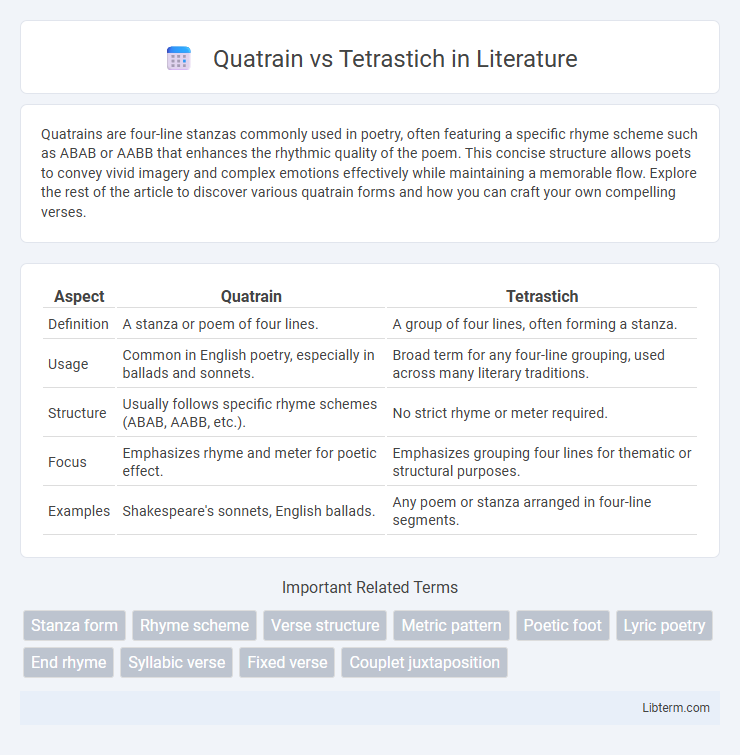Quatrains are four-line stanzas commonly used in poetry, often featuring a specific rhyme scheme such as ABAB or AABB that enhances the rhythmic quality of the poem. This concise structure allows poets to convey vivid imagery and complex emotions effectively while maintaining a memorable flow. Explore the rest of the article to discover various quatrain forms and how you can craft your own compelling verses.
Table of Comparison
| Aspect | Quatrain | Tetrastich |
|---|---|---|
| Definition | A stanza or poem of four lines. | A group of four lines, often forming a stanza. |
| Usage | Common in English poetry, especially in ballads and sonnets. | Broad term for any four-line grouping, used across many literary traditions. |
| Structure | Usually follows specific rhyme schemes (ABAB, AABB, etc.). | No strict rhyme or meter required. |
| Focus | Emphasizes rhyme and meter for poetic effect. | Emphasizes grouping four lines for thematic or structural purposes. |
| Examples | Shakespeare's sonnets, English ballads. | Any poem or stanza arranged in four-line segments. |
Introduction to Quatrain and Tetrastich
A quatrain is a four-line stanza or poem often used in various poetic forms, characterized by its rhyme schemes such as ABAB, AABB, or ABCB, and serves as a fundamental building block in classical and contemporary poetry. A tetrastich specifically refers to any four-line poetic unit, emphasizing structure without strict adherence to rhyme or meter, and is frequently found in ancient and modern literature. Understanding the distinctions between quatrains and tetrastichs enhances comprehension of poetic compositions and their rhythmic and thematic developments.
Defining Quatrain: Origins and Usage
A quatrain is a four-line stanza or poem known for its structured rhyme schemes, often originating from classical and medieval poetry traditions across cultures. Its usage spans diverse poetic forms such as the English ballad, the Turkish rubai, and the Persian ghazal, emphasizing its adaptability and rhythmic appeal. Recognized for its concise expression, the quatrain plays a crucial role in both formal verse and modern spoken-word poetry.
What is a Tetrastich? Meaning and History
A tetrastich is a stanza or poem consisting of four lines, commonly used in various poetic traditions for its balanced structure and rhythmic potential. The term originates from the Greek words "tetra," meaning four, and "stichos," meaning line, reflecting its composition. Historically, tetrastichs have been prominent in classical poetry, including ancient Greek and Latin works, serving as a foundational form in epigrams, hymns, and lyrical verse.
Structural Differences: Quatrain vs Tetrastich
A quatrain is a four-line stanza or poem commonly structured with specific rhyme schemes such as ABAB, AABB, or ABCB, often used in traditional poetry forms. A tetrastich also consists of four lines but is broadly defined without a fixed rhyme pattern or meter, allowing more versatility in poetic structure. The key structural difference lies in quatrains' formal rhyme and meter conventions, while tetrastich emphasizes four-line grouping without strict poetic constraints.
Similarities Between Quatrain and Tetrastich
Quatrains and tetrastichs both consist of four-line stanzas commonly used in poetry to create structured rhythmic patterns. These poetic forms often share similar rhyme schemes such as ABAB or AABB, contributing to their melodic and mnemonic qualities. Both quatrains and tetrastichs serve as foundational units in various poetic traditions, enhancing the thematic coherence and emotional impact of a poem.
Poetic Function and Purpose
Quatrains and tetrastichs both consist of four-line stanzas but serve distinct poetic functions and purposes. Quatrains are often used in structured, formal poetry to establish rhythm and rhyme schemes that enhance thematic development. Tetrastichs provide concise, standalone poetic units that emphasize brevity and impact, frequently found in epigrams or lyrical poetry.
Quatrain in Classical and Modern Poetry
A quatrain is a four-line stanza often used in classical poetry to convey structured, rhythmic, and rhymed verses, such as in Shakespearean sonnets and ballads. It remains prominent in modern poetry, where poets experiment with form while retaining the quatrain's concise, impactful expression of themes and emotions. Unlike the more general tetrastich, which simply denotes any four-line stanza, the quatrain carries specific traditional and cultural associations in both classical and contemporary poetic contexts.
Tetrastich Across Literary Traditions
Tetrastich, a four-line stanza form, appears prominently across diverse literary traditions including ancient Persian ghazals, classical Chinese poetry, and Western sonnets. This versatile structure supports a range of thematic expressions from meditative reflections in Sufi poetry to poignant imagery in Tang dynasty verses. Its adaptability in rhythm and rhyme schemes enables poets worldwide to convey complex emotions within a concise, harmonious framework.
Examples of Quatrain and Tetrastich in Literature
A quatrain is a four-line stanza common in English poetry, exemplified by Robert Frost's "Stopping by Woods on a Snowy Evening," where each quatrain follows an AABA rhyme scheme. A tetrastich also consists of four lines but is more flexible in form and often found in classical poetry, such as Persian ghazals or ancient Greek epigrams. William Blake's "The Tyger" showcases both forms, combining quatrains with consistent rhyme and the structural brevity characteristic of tetrastichs.
Choosing Between Quatrain and Tetrastich: Which to Use?
Choosing between quatrain and tetrastich depends on the poetic structure and intent; a quatrain is a four-line stanza commonly used with specific rhyme schemes like ABAB or AABB, often found in traditional poetry. A tetrastich simply refers to any four-line stanza without emphasizing rhyme or meter, offering more flexible use across various poetic forms. For structured rhyme and rhythm, a quatrain is preferred, while tetrastich suits free verse or experimental poetry.
Quatrain Infographic

 libterm.com
libterm.com